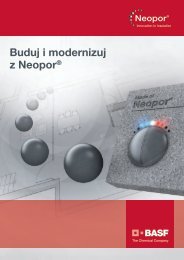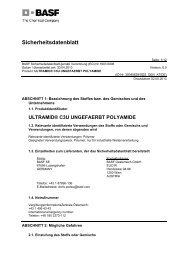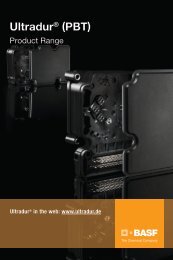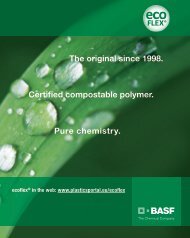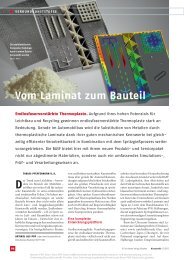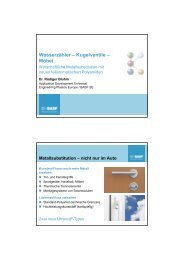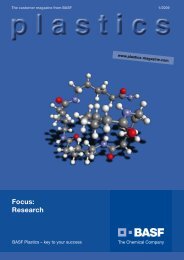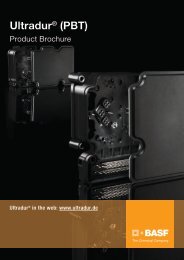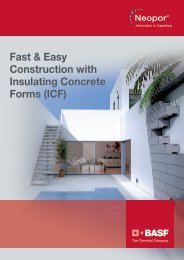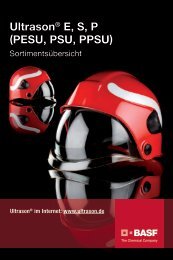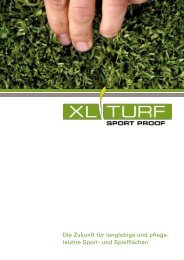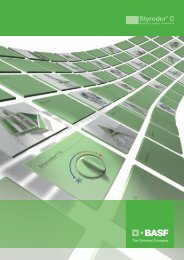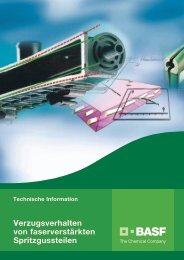plastics - The customer magazine from BASF 2/2007
plastics - The customer magazine from BASF 2/2007
plastics - The customer magazine from BASF 2/2007
You also want an ePaper? Increase the reach of your titles
YUMPU automatically turns print PDFs into web optimized ePapers that Google loves.
Markets and products<br />
New plastic specialty protects<br />
circuits against moisture.<br />
Same method,<br />
better bond<br />
“Our broad product line certainly contains<br />
<strong>plastics</strong> that bond well to metals. Our task<br />
was merely to further optimize this important<br />
property,” explains Gall. <strong>The</strong> breakthrough<br />
came with the new Ultramid Seal-Fit, which<br />
flows so easily that it actually fills every nook<br />
and cranny of the microscopic structures<br />
of the metal surface. “<strong>The</strong> special feature<br />
of these granules is that they can still be<br />
processed in conventional injection-molding<br />
machines like almost any other thermoplastic.<br />
This means that processors do not<br />
have to deal with a new process,” says Gall.<br />
And what is even more, there is no longer a<br />
need for complex pre-treatments involving<br />
materials that are not suitable for injection<br />
molding but that had been used up until now<br />
to affix the printed-board conductors so that<br />
they would not get all tangled up during the<br />
subsequent injection molding of the housing.<br />
“This bond is now simply created by Ultramid<br />
Seal-Fit,” is how Gall describes the<br />
advantage of the new solution. Fedler adds,<br />
“That’s<br />
the beauty<br />
of it: you simply<br />
use the existing injection-molding<br />
method but with<br />
a new material.” Okay. But are the printedboard<br />
conductors that are overmolded this<br />
way really tightly sealed? <strong>The</strong> engineers<br />
are all fired up that this is indeed the case<br />
and to prove it, they even put the material<br />
specimens into the oven. “We subjected<br />
the specimens one after the other to all of<br />
the usual climatic cycling tests as well as<br />
to harsh temperature-shock experiments,”<br />
says Fedler, describing the rigorous testing<br />
they conducted in-house. “Here, the parts<br />
had to withstand temperature fluctuations<br />
<strong>from</strong> -40°C [-40°F] to +50°C [122°F] within<br />
less than 10 seconds.” And they still had to<br />
be tightly sealed after this. Ultramid Seal-Fit<br />
firmly clings not only to the metal but also to<br />
the polyamide housing. “Polyamides adhere<br />
extremely well to each other, creating a tight<br />
seal here as well,”<br />
according to Gall.<br />
Besides, Ultramid Seal-Fit<br />
is somewhat softer then the<br />
fiberglass-reinforced material of the<br />
housing, so that it can also absorb the<br />
stresses that occur between the metal and<br />
the housing upon exposure to heat. “<strong>The</strong><br />
combination of our material know-how with<br />
the extraordinary technical testing competence<br />
of the Lüdenscheid Plastics Institute<br />
allowed us to come up with an innovation<br />
that benefits everyone,” summarizes <strong>BASF</strong><br />
expert Gall. “Manufacturers of electronic<br />
components can now make much better<br />
products without having to expend more effort<br />
and the OEMs can put safer cars on the<br />
market – with the result that the nightmare of<br />
electronic system failure is becoming a thing<br />
of the past.<br />
Further information:<br />
www.ultramid.com<br />
www.kunststoff-institut.de<br />
25



